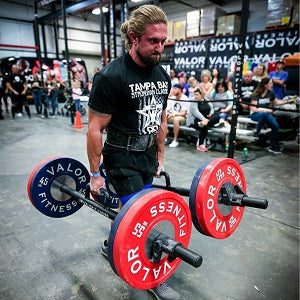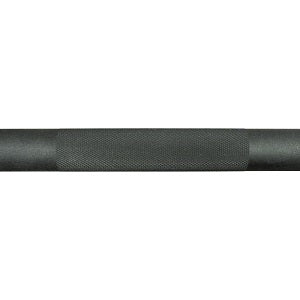So, you are looking for a new bar. Well, if you are looking for a new spot in town to meet up with friends after work, you might not find this guide very helpful. But if you mean bars as in BARBELLS then you’re in the right place.

With an abundance of options, you might be asking yourself what bar works best for you. While this post cannot pick a barbell for you, it may guide you in the right direction and provide some useful insight to find the best bar for you and your training. Whether you are a beginner looking for your first bar, or an experienced weightlifter adding to your arsenal of barbells, here are 5 Important Features of Bars You Should Consider:
1. Type of Bar
Not all bars are created equal – there are many kinds of bars that have their own specific benefits and uses or may be good for certain lifts or gyms and not so for others. For example, Olympic barbells are one of the most common you’ll see in any home or commercial gym. While different Olympic bars have different specs and benefits (more on that later), they are very well-rounded and can be used for almost every lift, both compound and Olympic and can benefit the newest athletes while still having a place in the programming of experienced lifters.

Then you have Specialty Bars. You may have seen these at your gym (often shaped differently than an Olympic bar), but never knew what they were for or how they were used. There is a plethora of specialty bars out there, each with their own use and benefits, but specialty bars are mostly used as their name suggests: as a specialty. These bars commonly specialize in only a few movements and have a very specific benefit, ranging from deadlift bars or logs to farmers walkand axle bars. While specialty bars can be used alone in your training, as they often are depending on the needs or limitations of the athlete, you will see the most benefit if these supplement your training in conjunction with an Olympic bar.

2. Knurling Pattern
You ever seen that crosshatched pattern on the barbells at your gym? You know, that slightly abrasive part where you place your hands? That, my friend, is the knurling. If you already know what knurling is, you rock (don’t worry – if this is new to you, you still rock), but you may be surprised to hear that there are different patterns of knurling, and that there is actual benefit to knurling rather than just aesthetics. While there are several different kinds of knurling, the 3 most common seem to be patterns referred to as hill, mountain, and volcano.

Hill patterns are the most passive of the 3. They are somewhat flat, despite the pattern, with the least amount of grip as the steel is not cut as deep as others. The hill pattern may also occur with extended use and abuse on a bar with more aggressive knurl. If you are warming up or training with low weight, then this may benefit you as it will not tear up your hands. But if you are serious about your grip (which you should be) and need something that will stick in your hands then you may need more than the passive hill pattern.
Mountain knurl patterns feature a diamond shape with a single point that makes the most contact and digs into the skin on your hand, enhancing your grip on movements such as deadlifts. The mountain is the most aggressive of the 3 and is common on power bars and some deadlift bars where you may be performing heavy singles. But while it can enhance your grip on the bar, it is not necessarily the best knurling for many lifts, especially when you are training for reps.
That brings us to the Volcano, which has a crater shape and a rim that makes contact with the skin. This sharp rim, though less aggressive than the single point on the mountain, has the most surface area to give you the most grip. This unique pattern is optimal for almost all movements, whether it be basic deadlifts to more advanced movements such as the clean & jerk. Valor Fitness has a wide range of Olympic bars, most of which feature a Volcano knurl pattern.
Knurl marks may impact which bar you purchase as well. These are knurl-free marks strategically placed in the knurl that serve as a guide for hand placement. There are 2 kinds of knurl marks: the powerlifting mark, which is placed closer to the center of the bar, and the Olympic mark that is placed closer to the sleeves. Many bars have both, indicating a multi-purpose bar, but others are more specific to the sport they are designed for and may only have one or the other.

Now that you know what your gym buddies mean when they talk about the knurling on their bars, we can dig into the next key feature of barbells you might not have considered.
3. Center Knurl
We are not done with knurling just yet, as a related key element that may impact your barbell purchase decision is whether a center knurl is beneficial for your training. A center knurl likely features the same or similar pattern to the rest of the knurling on your bar but is placed evenly between the knurling on each side of the shaft (the thinner part of the bar that you grip). The main difference between the center knurl and the split knurling on the shaft is the benefit – while the knurling on each side of the shaft is mainly for the grip in your hands, a center knurl is for the grip on different parts of your body or clothing.
"So, do I need a center knurl on my bar?" Well, it depends on your training. If you enjoy powerlifting or Olympic weightlifting, then a center knurl will certainly benefit you as it will assist both your back and front squat by keeping the bar in place on your back or chest/collar bones, gripping the material on your shirt. The same goes for the clean, and since the number of repetitions in Olympic lifts is not typically high, the center knurl likely will not bother you when pressing the bar overhead. Most men’s bars designed for Olympic weightlifting have a center knurl, while the women’s bars don’t need the center knurl as they are slightly shorter than the men’s so the knurling is closer to the center.

However, if you are performing high repetition Olympic lifts as you might in cross training, or the universally beloved thruster, then the center knurl may not be for you as the abrasive texture of the knurl may scrape your neck.
4. Sleeve Mechanics
A common feature of sleeves that is often bypassed is spin, an important factor especially for those who practice functional fitness or Olympic weightlifting. When the sleeves spin, the inertia caused by the plates as you move the bar from a below hip position to an above hip position is reduced. Spin also reduces the possibility of injury as you shift from a pronated grip in the power position to a supinated grip in the front rack or overhead position, which puts a lot of stress on the wrists. The mechanics inside the collar are designed to allow the bar to spin effectively and efficiently, depending on if the bar uses bushings or bearings.
Bushings are solid ring-shaped pieces of copper and have more friction than bearings. They are common in power bars that may be used for heavy compound lifts such as squats, bench press, and deadlifts. Since these push or pull movements do not put as much stress on the wrists or elbows as Olympic lifts, spin is not necessary so any bar with quality bushings are perfect for powerlifting and basic strength training.

Bearings are small balls or needles inside a sleeve that provide the bar with a smooth, consistent spin. Since bearings allow the bar to spin, these are common in Olympic weightlifting bars used to progress the bar from the ground to an overhead position. If the bar has needle bearings opposed to ball bearings, the sleeve will spin smoother and for longer.

If you like to perform more technical movements such as the snatch or clean & jerk you should consider a bar that uses bearings, especially one with needle bearings. But if heavy compound lifts are your jam, then bushings are well suited for your training.
5. End Caps
Everything inside the sleeve must be secured somehow. On the end of every sleeve, you will see some form of a seal that keeps the sleeve securely fastened to the shaft while keeping all pieces inside in place. While there are several different kinds of end caps, the 2 most common you will likely see are 1) a sticker with a retention clip, and 2) a hex bolt.
A retention clip is a C-shaped snap ring that fits in a groove on the inside edge of a sleeve. There is typically a second retention clip further inside the sleeve that works with the outer clip to sandwich a branding plate/sticker. If a bar has one of these, it is a good sign that it can handle being dropped and may spin well if it uses bearings (but you already knew that).

A sleeve w/ a retention clip and branding plate/sticker.
If you see a large hex bolt on the end, it would not be wise to drop this bar from any position. These bars will likely not spin well, so they’re not the best for any functional fitness movements. But if you are planning on only using this bar for basic squats and bench press, they can still do a job in your gym.

Well, if you are not an expert in barbell science after checking out this guide, then hopefully you have an idea of what kind of barbell works best for you after reading these 5 overlooked features. But before you go, always remember: NEVER DROP AN EMPTY BARBELL!
If you are still unsure or have a question not answered in this post, feel free to reach out!
